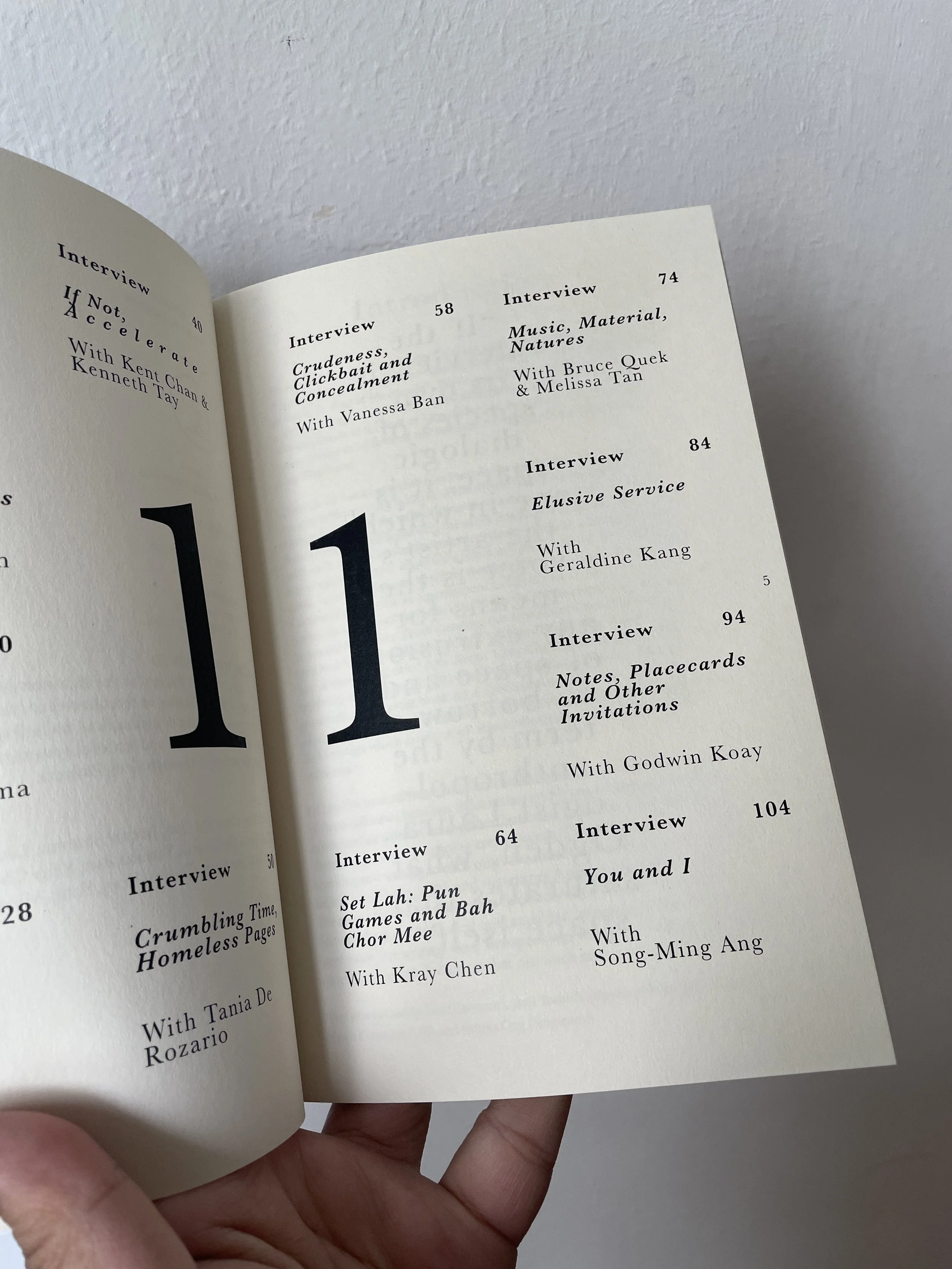11 Years, 11 Interviews



11 Years, 11 Interviews
11 Years, 11 Interviews
Jeremy Sharma, Lucy Davis, Kent Chan, Kenneth Tay, Tania De Rozario, Vanessa Ban, Kray Chen, Bruce Quek, Melissa Tan, Geraldine Kang, Godwin Koay, Song-Ming Ang
Publisher • Grey Projects
Year • 2019
Pages • 112
Dimensions • 14.8 x 21 cm
“It’s been eleven years since Grey Projects opened its first program on the 3 April 2008 with a pamphlet essay by Guo Liang Tan and an exhibition of works by four of his friends. We’ve moved from the all-concrete, street-facing space with the perforated aluminium doors to a first floor of a shophouse at the foot of Mount Sophia, to our current, and largest space, on the third floor of the last mid-twentieth century building on Kim Tian Road.
I remark on our changed spaces in order to mark the time, but also to recognise the moving realities of the artists who have moved with and alongside us, who not only offer us their art but often their words, their humour, ideas, weirdness and the other emotional gratifications of being with each other. Vertical Submarine welcomed me as a temporary member of their collective while we worked on The Garden of Forking Paths in 2009. Subsequently, one VertSub member Justin Loke joined the Young Curators Programme as a participant in 2015, and another ex-member Joshua Yang has had two solo exhibitions of his drawings and paintings in our current space. From curating our first show, Guo Liang returned for a two-hander exhibition in 2017 with Sookoon Ang, on the vocabulary of movement, titled Alfa Tango. Kray Chen went on a Grey Projects residency to Barcelona in 2014, and later developed his first ever solo presentation and artist book It’s A Set Situation with us in 2016. The independent art space in Singapore is, in the cosmology of spaces, a Kuiper Belt through which artists mark these elliptical paths and generative collisions.
Of late I’ve noticed how the interview has become an inadvertent record of these collisions between these artists and I, sometimes as a result of an exhibition we worked on together, but other times the interview functions as a cut into an ongoing conversation (Lucy Davis and I have been speaking and writing to each other for some time now, and I very much believe we will continue), and sometimes it signals the end of one. The means for the interviews are decidedly early twenty-first century. Some of these are conducted over email but increasingly these interviews were more ‘live writing’ than ‘live speaking’, where exchanges were made on a shared online document that can track each writing as it happens, where editing and revising by one participant can be simultaneous to another’s reading and writing. Godwin and I for example sat diagonally across the same table and wrote most of our interview over a long afternoon. It is also possible for the responses to lag for extended, even over- extended, stretches. Jeremy’s interview ended two years after it began, the longest any interview I’ve done has taken, with our prompts and clarifications to each other leaping across WhatsApp, Google Docs and email.
In our way and time, the interview becomes a conversation without interruption, each writer with the affordances of electronic time to respond as slowly or as long as they wish. If the interview is its own species of dialogic space, it is one in which the artist’s voice is the means for any extrusion of space and, to borrow a term by the anthropologist Laura Ogden, what saturates that space itself. With the voice given expansive airing, the interviews offer a ‘first-handedness’ to the artist that is difficult for criticism or art history to reach. Even journalistic reportage and the documentary can often only do so by quotation or citation. Yet saturation isn’t the same as authority, it is not the same as privileging the artist’s intent and statements. It is one way to make artist writing the page upon which challenges, pushbacks, obtrusions, insistences and resistances are performed, a way of turning art writing and the artist voice into the grounds upon which these forms of generative agonisms can be placed and activated.
I’m not sure what the next eleven years will hold, for myself or for Grey Projects. I mean, can anyone know their future? I do believe the adage that to take stock is to prepare to die, and to archive is to take on a museological view, one downwards into the cold earth. This volume is meant for neither perspective. This volume is not comprehensive, it does not include all the interviews that took place till 2019; those we might leave for the next volume. Instead, how else can an artist’s speech intercut into an artist’s writing? How live and alive can art writing be? What else could an interview become? What manner of proximity is this, between artists, between words, between exhibitions? I’ll stay however long more, however necessary, with these questions.”
— Jason Wee
